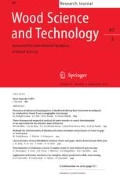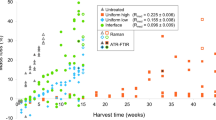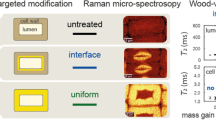Summary
Strips and blocks ofPinus sylvestris were acetylated for different periods of time. These, along with control samples, were tested for their tensile modulus, hydrophobicity and dimensional stability. The modulus of elasticity (tensile modulus) for each sample was derived using a statistical approach. The observations in this work suggest that the acetylation process significantly reduces the tensile modulus of the wood compared to its untreated state in an irreversible manner, and that the extent of the deterioration in tensile modulus is a function of the acetylation conditions. Acetylation improved significantly the hydro-phobicity and the dimensional stability of the wood as measured by the roll angle and swelling tests respectively. It appears therefore that acetylation using acetic anhydride in xylene has an optimum set of reaction conditions that compromise between the gains in water repellence and dimensional stability with the deterioration in mechanical properties.
Similar content being viewed by others
References
Dinwoodie, J. M. 1989: Wood: Nature's Cellular Polymeric Fibre-composite. Published by The Institute Of Metals, London
Gerhards, C. 1982: Effect of moisture content and temperature on the mechanical properties of wood. Wood and Fiber. 14(1): 4–36
Rowell, R. M.;Gutzmer, D. L;Sachs, I. B.;Kinney, R. E. 1976: Effects of alkylene oxide treatments on dimensional stability of wood. Wood Sci (9): 51–54
Rowell, R. M.;Ellis, W. D. 1978: Determination of dimensional stabilization of wood using the water-soak method. Wood Fiber (10): 104–111
Rowell, R. M. 1982: Distribution of acetyl groups in southern pine reacted with acetic anhydride. Wood Sci. (15): 172–182
Rowell, R. M.;Lichtenberg, R. S.;Larson, P. 1993: Stability of acetylated wood to environmental changes. Wood Fiber Sci. (25)4: 359–364
Tarkow, H.; Stamm, A. J.; Erickson, E. C. O. 1991: Acetylated wood. Forest Prod. Lab. Report No. 1593
Youngquist, J. A.;Krzysik, A.;Rowell, R. M. 1986: Dimensional stability of acetylated aspen flakeboard. Wood and Fiber Sci. (18)1: 90–98
Author information
Authors and Affiliations
Additional information
We would like to acknowledge the support of Unilever Research in providing the materials testing machine used in this work, and for the supportive discussions with Hickson & Welsh concerning the results
Rights and permissions
About this article
Cite this article
Ramsden, M.J., Blake, F.S.R. & Fey, N.J. The effect of acetylation on the mechanical properties, hydrophobicity, and dimensional stability ofPinus sylvestris . Wood Sci.Technol. 31, 97–104 (1997). https://doi.org/10.1007/BF00705925
Received:
Issue Date:
DOI: https://doi.org/10.1007/BF00705925




